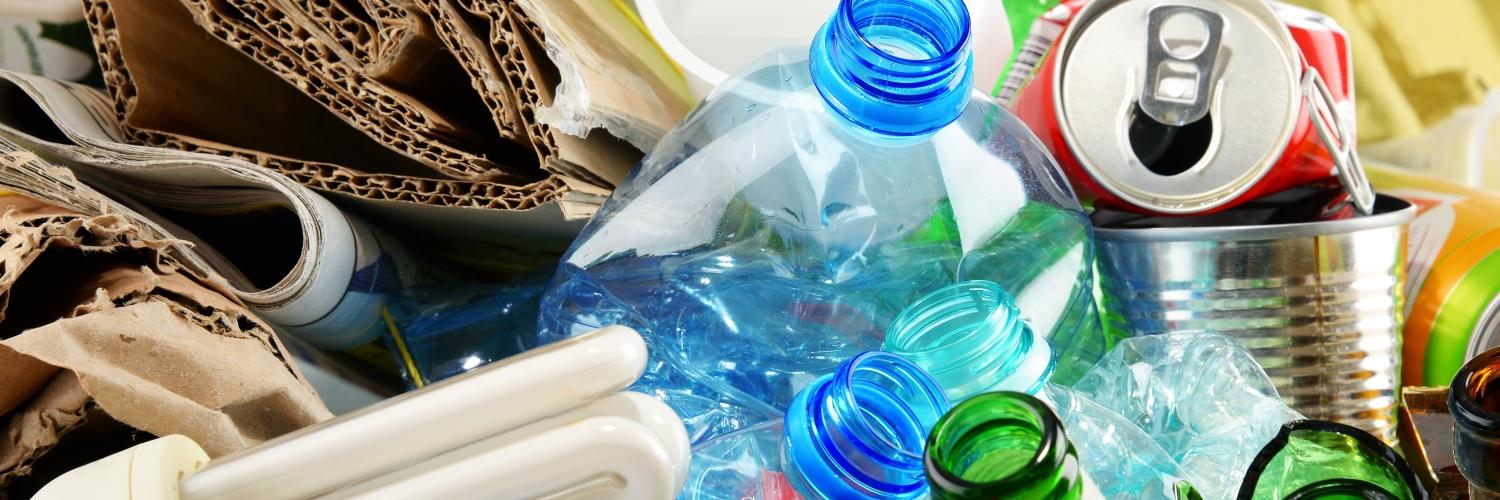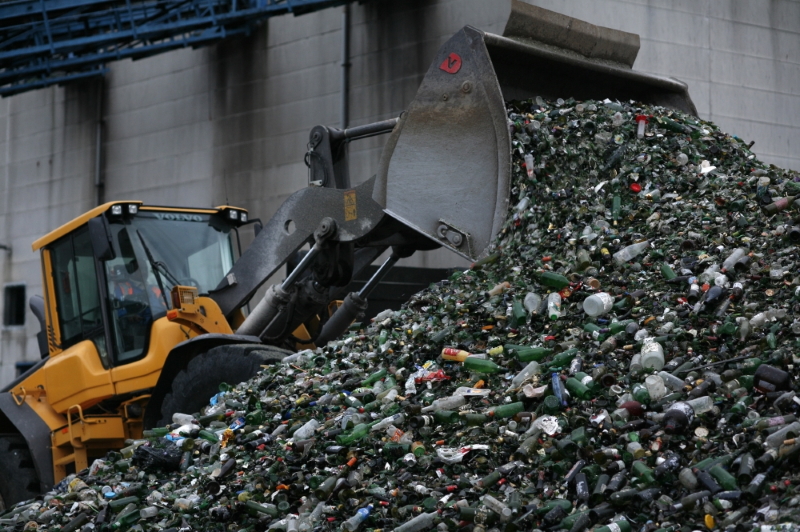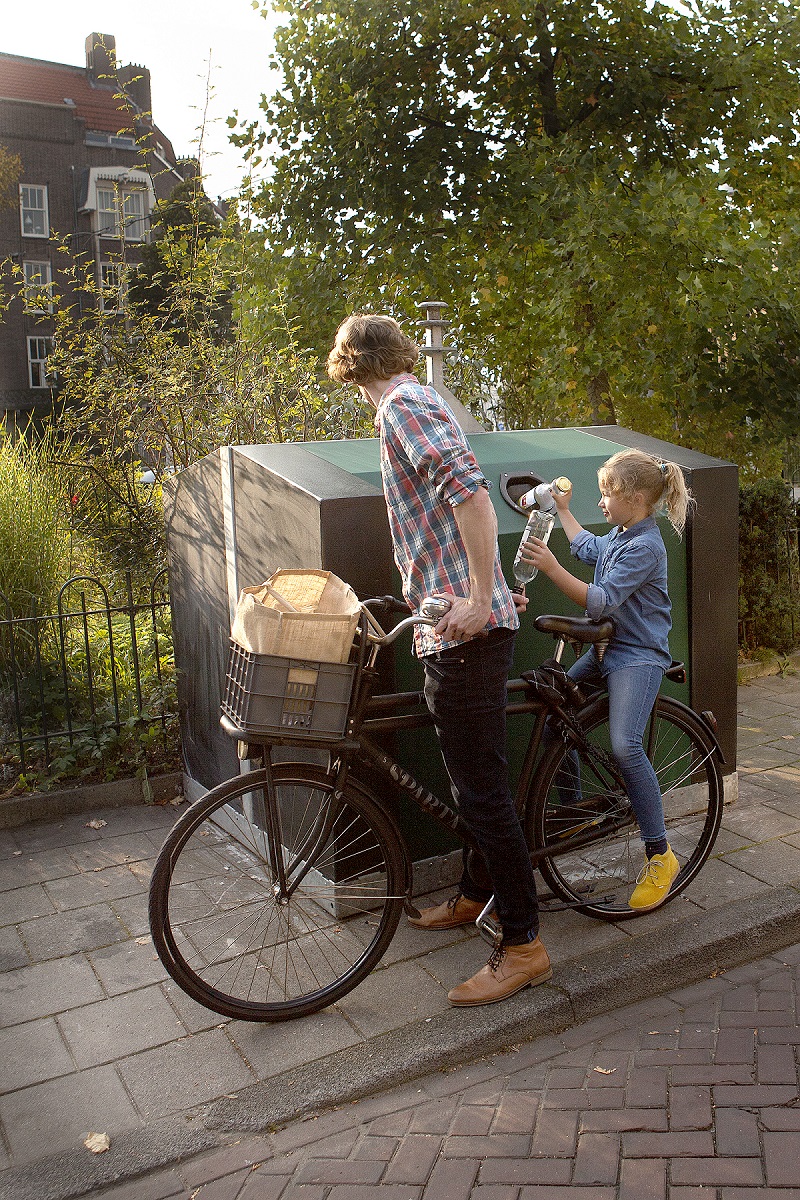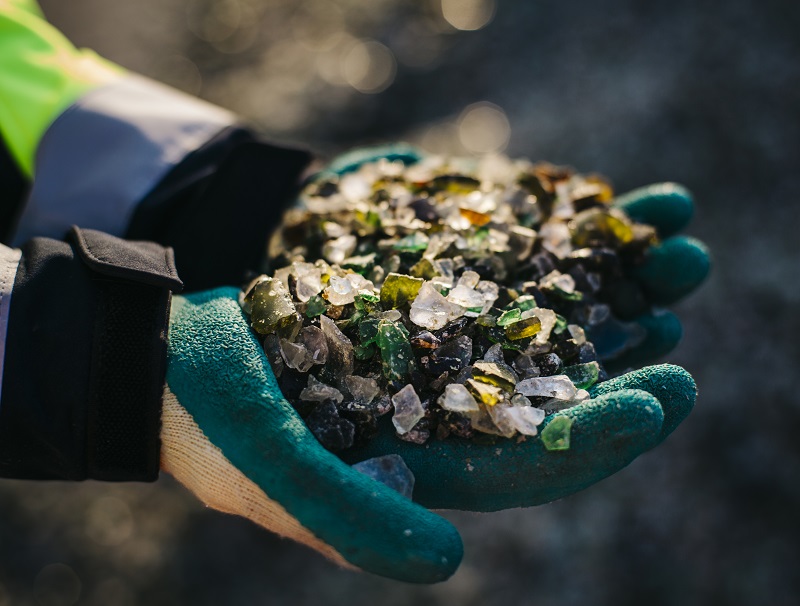
News
11 July 2019
Glass manufacturers drive up purity standards
Glass collection focuses on quantity, not quality
A circular economy requires a greater focus on quality. Separating wastes only makes sense when the materials are actually recycled - and preferably to the highest possible standards. The DWMA is publishing a series of articles on the quality of waste streams. This second article is on packaging glass.
The classic symbol of Dutch waste separation is the bottle bank, or glass recycling container, and it has been part of the street scene for more than forty years. There are now more than 25,000 of them. But despite this, the statutory target of 90% collection for recycling has not yet been reached. In 2017 the collection rate just reached 86% of the packaging glass on the market. 'The percentage is rising slightly. The rate recorded in the 2016 monitoring report was 84%,' says Gijs Duivenoorde, innovation manager at Nedvang, the organisation that registers and stimulates packaging collection and recycling for the packaging industry.
Nine out of ten people in the Netherlands don't know that wine glasses should go in the residual waste container (photo: Nedvang)
Effect on quality
That even higher collection rates will not diminish the quality of the resulting recycled material makes glass more recyclable than other waste streams. 'Municipalities are currently working hard to reduce the amounts of residual waste, in pursuit of the government's targets for 2020 of 100 kilograms of residual waste per person and 75% waste separation,' explains Duivenoorde's colleague Jan van der Ven. Diftar (differentiated tariffs), reverse collection (in which recyclables are collected kerbside but residual waste has to be taken to a drop-off facility) and reduced frequency collection systems all help to reduce the amount of residual waste, he says, but they can have an adverse effect on quality. 'For PMD - plastic, metal and drink packaging - we see a clear drop in quality. For glass the effect is minimal. We monitor the level of contamination each year and it is still well below the 2.5% quality specification.' According to Duivenoorde, that is all down to the bottle bank. 'Bottle banks have become part of everyday life and have small openings, so you can't stuff rubbish bags into them.'
Jan van der Ven (Nedvang):
"Contamination levels are still well below the 2.5% quality specification."
Risk of breakage and cutting incidents
The biggest issue with glass collection at the moment is not quality but quantity. Nevertheless, the recyclers have a lot of work to do to clean up the recyclate. Labels, metal caps, lids, plastic, food waste, other types of glass and 'ceramics, porcelain and stone' (CPS) all have to be removed. 'Every piece of stone or porcelain increases the risk of new bottles breaking,' explains Bianca Lambrechts, commercial manager at Maltha. Nor should leaded glass and heat-resistant glass, such as oven dishes, be put into bottle banks. 'Their higher melting points lead to cutting incidents when the molten glass is cut. Pieces can fly off, which is very dangerous.' Three-quarters of the domestic glass waste stream ends up at Maltha, the only glass recycler in the Netherlands. 'At two sites, Heijningen and Emmen, we process around 400,000 tonnes of packaging glass each year,' says Lambrechts. This consists of drying, crushing, sieving and optical separation of the cullet.
Bianca Lambrechts (Maltha):
"Better communication and awareness raising will lead to better quality."
Recycling target in perspective
The 90% recycling target should not be the last word, advises Coenraad Westbroek, consultant at Berenschot. 'Do the additional costs of the last few steps justify the investment? Couldn't we use all that money, time and energy more effectively by putting it into other circular measures,' he wonders. There are plenty of other more promising sustainability ambitions, he says. 'The opportunities for more circular solutions in glass recycling are legion, including reducing carbon emissions, for example by installing modern energy-efficient furnaces and reusing residual heat, and producing less packaging glass by making packaging lighter. Measures such as these also contribute towards the circular economy.'
Coenraad Westbroek (Berenschot):
"The 90% recycling target should not be the last word.
Judged on quality
Glass recycling is all about quality, says Maltha director Eric Herman. 'Every batch we process is inspected and has to meet the high quality standards set by the glass manufacturers. And they are driving up their purity standards. Several years back as much as 50 grams of CPS per tonne of glass was acceptable. That has now been reduced to 20 or even 10 grams per tonne.' The demand for recycled glass is enormous. Glass factories are eager to get their hands on it. 'The manufacturers want to use as much recycled glass as they can. About half the content of clear glass is made from cullet, and the figure for coloured glass is more than 80%. If contamination levels are reduced, these amounts can be raised even further, as long as the price of cullet is not too high. When cullet replaces primary raw materials, reuse goes up and energy use, CO2 emissions and costs go down.'
Eric Herman (Maltha):
"More contamination means that we have more sorting and separation to do and are left with a larger residual stream and higher processing costs."
Residual stream
In 2015 Maltha increased the quality of its recycled glass by renovating or replacing almost all of its separation machines. Herman: 'We can now recover more raw materials of a better quality. We used to produce clean cullet at sizes from 8 mm across, but now we produce clean cullet in sizes down to 4 mm.' Maltha makes use of advanced separation techniques, such as infra-red, magnet, X-ray and laser technology. Nevertheless, every stage of separation involves some loss of material. Herman: 'Contaminants are ejected from the conveyor belt by compressed air jets. This is never totally accurate and some clean glass is always removed by accident. If the contamination levels of collected glass were lower, we would lose less clean glass during the separation stages.'

The quality of the input stream is declining, while the glass manufacturers demand increasingly higher quality standards (photo: Maltha)
Affordability
Maltha is faced with a decline in the quality of the input stream, while the glass manufacturers demand increasingly higher quality recycled glass. 'More contamination means that we have more sorting and separation to do and are left with a larger residual stream and higher processing costs.' It is the costs that are of greatest concern to Herman. 'Technically, we are capable of producing recycled glass of the required quality - but how long will recycled glass be affordable? Disposing of the residual waste stream has become incredibly expensive, partly because of the higher waste disposal charges.' Lambrechts observes that the quality of collected glass varies considerably from place to place. Glass from the cities contains more contamination than glass from rural areas. At the same time, the main towns and cities are where Nedvang wants to raise recycling rates. 'That is where the greatest potential lies. Some cities still only collect as little as ten kilos per inhabitant, whereas the average is around 20 kilos,' explains Van der Ven.
Clear communication
Better communication and awareness raising will lead to better quality, expects Lambrechts. 'We need to get across much more clearly what people should put in the bottle bank and what they should not. Nine out of ten people don't know that wine glasses should go in the residual waste container,' she says. Vera Dalm, director of Milieu Centraal, which provides practical advice to the public on sustainability and recycling, wants to make it as easy as possible for people. 'Lower the threshold as much as possible. Don't set complicated rules with lots of exceptions, but give a clear message that everyone can easily grasp,' she advises. Her maxim is: the more complex the message, the worse the quality of the collected waste. 'Can't we shift the problem of quality away from the consumer and focus our efforts on better sorting? After all, glass is not the only waste that people have to separate; there are rules for recycling all sorts of household waste.'
Gijs Duivenvoorde (Nedvang):
"Post separation of glass must not be allowed to replace source separation."
Is post separation the answer?
Fourteen per cent of all packaging glass ends up in the residual waste stream. Recently a start was made with recycling some of this waste stream using post separation techniques. 'Inert glass, stone and sand is recovered from residual waste before incineration and is turned into a building material. One of its uses is as a cap for landfills,' says Gijs Duivenoorde of Nedvang. This application qualifies as recycling and accounts for 1.5% of all recycling. Nevertheless, Duivenoorde does not believe post separation is the best way to achieve the recycling targets. 'Certainly not. Post separation of glass must not be allowed to replace source separation. The quality of the end product is much lower and the costs are five times higher.' Bianca Lambrechts of Maltha is worried that the message is becoming confused. 'Post separation clouds the message to the public. Packaging glass should always be put in the bottle bank and not thrown away with residual waste. Besides, post separation losses are much higher than in the bottle bank route.'
Familiar territory
Consumers are generally sure about the rules for glass recycling and Milieu Centraal receives relatively few questions about glass. Dalm: 'Glass does not figure in the top ten questions in our waste guide. The bottle bank is familiar territory. Contamination is less of a problem for glass than for waste streams such as plastic and PMD.' To raise quality levels, Dalm points to the option of introducing a deposit scheme. 'Small no-deposit beer bottles are appearing on the market again, but a deposit system delivers more and better quality recycled glass. And that, after all, is what it's all about.'
Vera Dalm (Milieu Centraal):
"Choose a clear message that everyone can easily grasp."
Not in the bottle bank
In the Netherlands bottle banks are only for packaging glass, not for
- Pottery: not made of glass
- Crystal glass: contains lead oxide, which would end up in the new glass if recycled
- Lightbulbs: incandescent and halogen lightbulbs contain hardened glass; energy saving light bulbs and fluorescent tubes contain small amounts of mercury
- Opal glass: contains fluorine, which would be emitted with the waste gases during the production of new glass
- Mirror glass: has a different composition from packaging glass
- Heat-resistant or refractory glass: has a higher melting point than packaging glass and disrupts the recycling process
- Drinking glasses: may be made of heat-resistant glass
- Window glass: has a different composition from packaging glass
- Glass dishes: may be made of heat-resistant glass
- Picture frame glass: may be window glass
- Vases and decorative bottles: may be made from different types of glass or ceramics

Bottle bank in the Netherlands (photo: Nedvang)

